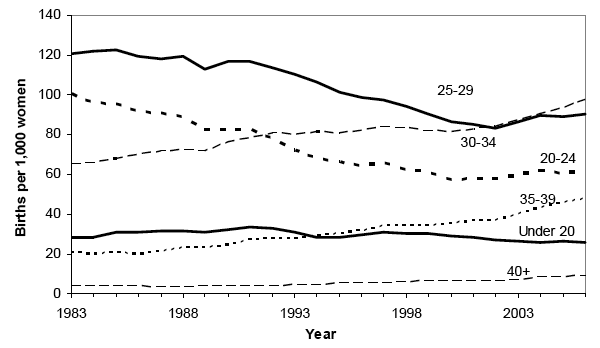
Fertility assumptions are agreed in two stages. The long term assumption is decided as part of the consultation process between the UK countries and the Office for National Statistics. Then there is a detailed assumption setting to produce the age-specific fertility rates for each year of the projection period that are consistent with this long-term assumption.
Fertility assumptions of long term average completed family size for the 2006-based projections are slightly higher than those used in the previous 2004-based projections. The assumptions for Scotland and other constituent countries of the UK are given in Table A1.
Table A1 Assumptions of long-term average completed family size
2004 and 2006-based projections
2006-based |
2004-based |
|
|---|---|---|
England |
1.85 |
1.75 |
Wales |
1.85 |
1.75 |
Scotland |
1.65 |
1.60 |
Northern Ireland |
1.95 |
1.80 |
United Kingdom |
1.84 |
1.74 |
Recent data have shown increases in fertility rates over the past five years. Fertility rates for women in their thirties have continued their sustained increase over recent decades, while fertility rates for women in their twenties have stopped declining and even seen some modest increases since 2001.
Fertility assumptions are formulated in terms of the average number of children that women born in particular years will have. This cohort measure of fertility is more stable than the analogous calendar year or period measure (the total fertility rate). This is because it is affected only by change in the total number of children women have and not by the timing of births within their lives. Period rates may rise or fall if births are brought forward or delayed for any reason.
The assumptions about completed family size are based on family building patterns to date and other relevant data. For the UK as a whole the steady decline in achieved family size at each age, a clear pattern for the 1945 to 1975 cohorts, appears to be bottoming out among the most recently-born cohorts of women. It is assumed that the completed family size will continue to decline until the early 1990s cohorts and then level off at 1.84.
The trends in age specific fertility for Scotland are shown in Figure A1. Up until 2002, there is a general pattern of falling fertility at younger ages coupled with rises in fertility at older ages. From 2002, with the exception of the under 20 group there have been increases in fertility.
Around 1980 the fertility levels in Scotland were similar to the UK, but they have shown a more rapid decline in age specific fertility at ages between 20 and 29. The fertility rates in the under 30s are currently 90 per cent of those in the UK as a whole.
Figure A1 Scotland Age Specific Fertility 1983-2006

More details on the background of how the fertility assumptions are derived can be found in "Population Trends 114" on the Office for National Statistic’s website through the following link:
http://www.statistics.gov.uk/downloads/theme_population/PT114.pdf.